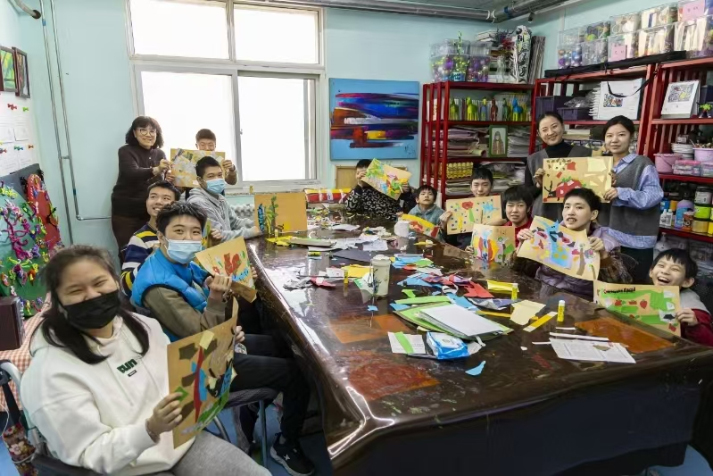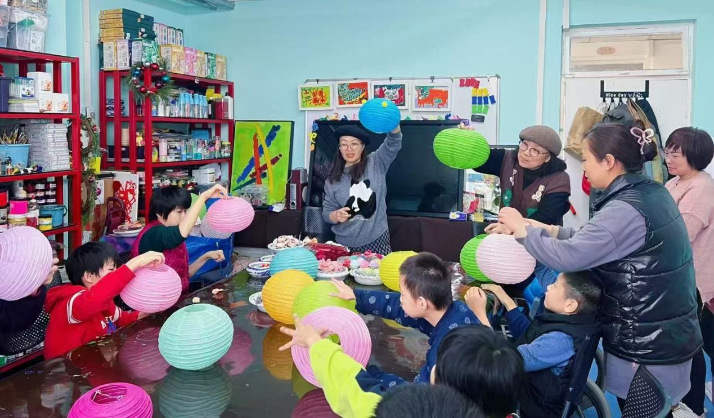| China |
| Special education and rehabilitation rewrite futures for children in China | |
|
|
 Children hold up their paintings at the Chenguang Cerebral Palsy Rehabilitation Service Center in Beijing's Chaoyang District on November 29, 2024 (COURTESY PHOTO)
'Most people can climb the stairs to enter society on their own, whereas some people cannot because of a disability. We are obliged to build ladders for those who need a helping hand." This is the guiding principle of Zhang Huanxia, head of the Chenguang Cerebral Palsy Rehabilitation Service Center in Chaoyang District, Beijing. Having been committed to rehabilitation services for children with disabilities for over 20 years, Zhang has witnessed the rapid development of the field and is now looking at a brighter future for these children with extra help from society and government. She refers to her work as "a career that can change people's destinies." "Children receiving special education often require more time and energy from us compared with regular children. We're not just helping them recover from their conditions on a medical level and giving them the school courses—we're teaching them how to perceive life and the world at large, preparing them for future education and social integration," Zhang told Beijing Review. "I spend long hours with these children every day, and they are like my own. I believe most special education teachers also feel this way." Special treatment Special education refers to personalized educational services designed for individuals with physical, mental or learning disabilities. It provides equitable developmental opportunities through adapted curricula, specialized instructors and assistive technologies. Its target group includes children with visual and hearing impairments, speech and language disorders, intellectual disabilities, physical disabilities, as well as mental and learning disabilities. According to statistics from the China Disabled Persons' Federation (CDPF) , as of 2022, China had 1.2 million children aged 0-15 with certified disabilities. If we include uncertified numbers, who have only mild symptoms but do require special education services throughout their nine-year compulsory education, estimates suggest the total number is much larger. "In the 1990s, most rehabilitation centers were general facilities serving a large variety of disabled children with diverse needs," Zhang said. "After the year 2000, specialized centers that focus on only one or two types of disabilities began emerging across the country. China's special education system is becoming increasingly standardized and professionalized. Additionally, modern rehabilitation centers now integrate three core functions: education, therapy and medical care under one roof. This system allows students to access the whole package in one institution." Zhang's institution, which provides rehabilitation and education exclusively for children with cerebral palsy (CP), was established in 2009 with support from Chaoyang District authorities. "Since our founding, the Beijing Municipal Government has provided us with a monthly subsidy of 3,600 yuan ($492) for each student," Zhang said. "This helps alleviate costs for children from disadvantaged families. With subsidies, parents only pay 120 yuan ($16.4) for a half-day program, which suffices for children with CP." Government support aside, Chenguang receives over a dozen donations annually from local communities and businesses. These include daily necessities, rehabilitation equipment and human resources, including voluntary hours, lectures and courses. With over 15 years specializing in CP treatment, Zhang has worked with more than 1,000 children. Most of them suffered from mobility and cognitive impairments caused by CP—particularly gait dysfunction. Therefore, teaching these children to walk normally remains a great challenge for Zhang and her staff. "I don't think there are many fundamental differences between children with CP and their peers," Zhang said. "Their cognitive abilities, perception and communication skills match those within their age group—they simply face mobility challenges. Our core mission is helping them to walk independently through physical rehabilitation." "While some children progress rapidly within a month, the average rehabilitation period spans one to two years," she added. One standout case is a boy from Hebei Province who began to walk independently after just three months of therapy. "He transitioned seamlessly back to school, where he's thriving with a full teenage life—study, friends and activities. This is our biggest reward," Zhang said.  Volunteers from art studios offer an art session for children at the Chenguang Cerebral Palsy Rehabilitation Service Center in Beijing's Chaoyang District on February 21 (COURTESY PHOTO)
Continued progress Zhang observes that growing public awareness campaigns and disability education have significantly improved social acceptance of special needs communities. "A decade ago, when I took our children to local supermarkets or parks—vital training for both mobility and social cognition—they'd attract stares or even teasing from children who didn't know why they walk the way they walk," Zhang recalled. "That rarely happens now." Chenguang also actively promotes public awareness on special education through original performances and exhibitions, starred in and hosted by its staff and students. "These initiatives help other children understand their peers with disabilities, reducing future risks of bullying and discrimination. For the children themselves, it builds self-esteem that in turn supports their rehabilitation," Zhang explained. After receiving training at rehabilitation centers, some children can afford to enroll in full-time special education schools, but the majority of children with disabilities in China now choose to attend mainstream classes in regular schools. This poses a new challenge: These schools often lack trained special education teachers and sensory integration equipment, which means that the children still need further support from society and government alike. China is committed to boosting the popularization and long-term development of special education. According to Global Education Monitoring Report released by UNESCO in 2023, the country allocated 6,000 yuan ($817) annually for each student in the compulsory-stage special education schools—triple the funding for regular schools—while constructing 12,000 specialized resource classrooms between 2020 and 2023 to cover 70 percent of county-level districts. Beyond developed educational hubs like Beijing, particular attention also goes to ensuring enrollment in remote, economically disadvantaged regions, demonstrating a commitment to equitable access to education across China's diverse geographic and socioeconomic landscape. In January 2022, an action plan on special education released by the State Council set the goal to raise the enrollment rate of school-age children with disabilities in compulsory education to 97 percent and the annual subsidy for each student to 7,000 yuan ($958) by 2025. A compelling example is the increased enrollment rate of Leishan County Minzu Special Education School in Qiandongnan Miao and Dong Autonomous Prefecture, Guizhou Province in southwest China. The local government has pioneered an innovative "1+N" classroom model—where one county-level special education school broadcasts lessons via livestreaming platforms to multiple township schools that do not have special education teachers. Special education teachers can coach remotely while local classroom teachers provide in-person support to students with disabilities. This breakthrough system ensures children with disabilities in remote mountainous areas, especially those whose families cannot facilitate county school attendance, can have access to special education. Since implementing this model, Qiandongnan has seen its enrollment rate for children with disabilities surge from 76 percent in 2018 to 94 percent in 2023. "After receiving rehabilitation training and special education, children with disabilities can achieve the same academic performance and career opportunities as their peers—and it is our responsibility to ensure they have access to these opportunities," Zhang said. "When I look at these children, I see limitless potential in their future. Supporting them is not just a moral obligation for a country and society—it is a commitment to social equity." Zhang added, "I hope that in the next two decades of my career, I will witness continued progress in this field—through advancements in technology, professional training for human capital, public engagement and policy development—as I have in the first two decades." Copyedited by Elsbeth van Paridon Comments to zhangyage@cicgamericas.com |
|
||||||||||||||||||||||||||||
|